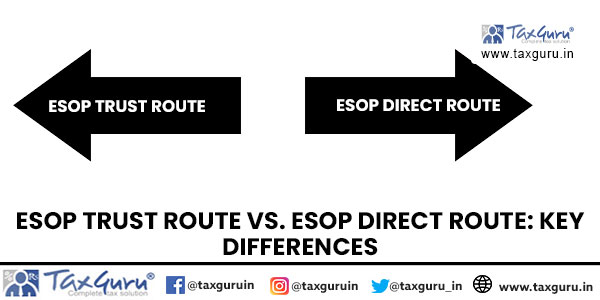Summary: Employee Stock Ownership Plans (ESOPs) serve as an effective mechanism for companies to attract, retain, and motivate key talent, particularly in startups and tech firms in India. Companies can issue shares to employees through two main methods: the ESOP Direct Route and the ESOP Trust Route. The Direct Route involves the company issuing stock options directly to eligible employees, who can exercise these options after a vesting period to receive shares. In contrast, the Trust Route requires the establishment of an employee welfare trust that holds shares in a fiduciary capacity for employees, allowing for either fresh issues or secondary market acquisitions of shares. The Direct Route is advantageous for companies with fewer employees due to its streamlined processes, though it can lead to delays in share allotment. The Trust Route, while increasing administrative workload and compliance requirements, is favored for companies with a larger employee base, offering benefits such as internal marketplaces and efficient share transfers. Notably, both routes have limitations, including a cap on the monetary loans a company can extend to the trust for share acquisition. Ultimately, the choice between these two methods depends on the company’s structure and goals, with the Trust Route gaining traction for its effectiveness in stock option management.

Companies use ESOPs as an effective tool to attract, retain and grow the key talent pool and motivate employees for the best outcome. It is also helpful to generate the sense of ownership among the employees. This practice is gaining extreme popularity in India with employees preferring ESOPs over cash component especially in startups and tech companies.
There are two ways to issue and allot shares to the employees under ESOPs, they are as follows
| ESOP Direct Route | ESOP Trust Route | |
| Meaning | It is a route where the Company issues stock options under ESOP to the eligible employees and such employees after the vesting period is over directly exercise their options and Company allots shares against options exercised by the employees. | It is a route where trust is created. This trust keeps shares in a fiduciary position for the employees and whenever employee exercises his option, trust transfers shares to the employee who has exercised his/her options. |
| Mode of acquisition | Fresh issue of shares only | Existing shares (secondary market acquisition) or
Fresh issue of shares both options may be taken |
| Steps | -Granting of ESOPs post Board and shareholders’ approval.
-After vesting period employee exercise the option by making payment of exercise price along with applicable taxes to the Company. -On exercise of an option company issue the shares to the employees. |
|
| Advantages | -Suitable for ESOP program with smaller number of employees or single ESOP plans. |
|
| Disadvantages | – Takes more time to allot shares in the Demat account after exercise is done.
– Multiple allotments / listing applications in case large employee base and longer exercise period. |
– Additional compliance and paperwork
– Increases administrative workload w.r.t. trust Audit, filling etc. – Listed companies can use secondary shares only upto a maximum of 5% of the equity capital for ESOP purposes. – Further, all public companies (listed and unlisted) have a monetary ceiling of loan that can be given by the Company to the ESOP trust to acquire shares up to 5% of paid-up share capital and free reserves. – Loan limitation of Company. |
Whether or not to have a Trust Structure to implement the ESOP is entirely the Company’s choice. Owing to significant advantages of Trust route over direct issuance route, the trust structure is becoming an increasingly popular choice for effective stock option management.




